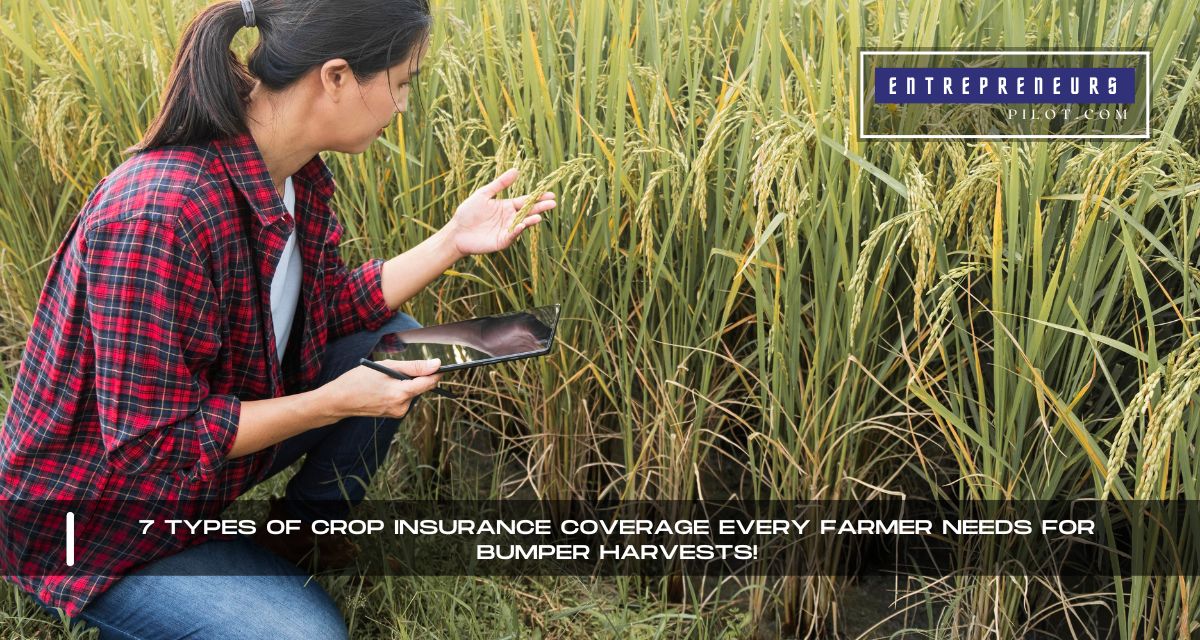Introduction
As the backbone of our nation’s food supply, farmers face a myriad of risks that can turn a season of hard work into uncertainty overnight. Weather, pests, and market fluctuations are just a few of the challenges lying in wait. But here’s the good news: with the right Types Of Crop Insurance Coverage, you can shield your hard-earned yield from these unpredictable forces. This guide unveils the seven essential types of crop insurance coverage every farmer needs to ensure bumper harvests year after year.
Whether you’re cultivating acres of corn or a boutique vineyard, understanding and selecting the right insurance coverage can be the difference between a year of prosperity and one of hardship. Let’s dive in and explore how you can safeguard your agricultural endeavors.
Table of Contents
Multiple Peril Crop Insurance (MPCI)
Multiple Peril Crop Insurance is the cornerstone of agricultural risk management. It offers comprehensive protection against a wide range of natural disasters such as drought, flood, hail, and more. Think of MPCI as a safety net that catches you when the weather turns against you. With climate unpredictability on the rise, securing an MPCI policy isn’t just wise—it’s essential for every farmer aiming for stability in an unstable world.
Crop-Hail Insurance
While MPCI covers a broad spectrum of perils, Crop-Hail Insurance focuses specifically on damage caused by hail—an all too common and sudden threat to crops. Unlike MPCI, which is subsidized and regulated by the government, Crop-Hail Insurance is provided by private insurers and can be purchased at any time during the growing season. It’s a perfect add-on to MPCI, offering an extra layer of protection that can make all the difference when a hailstorm hits.
- For Expert Financial Insights And Guidance, You Can Visit Our Sister Site – ArabsGeek.com Now!
- Curiosity Piqued? Dive Into the Most Captivating Financial Content by Visiting Our Homepage!
- Unlock Exclusive Business Opportunities! 🚀 Connect with Us Now at our Email: [email protected]!
Revenue Protection Insurance
Revenue Protection Insurance goes beyond the physical loss of crops, safeguarding against price fluctuations in the market. This type of policy ensures that farmers receive a guaranteed revenue based on projected prices and yields, providing peace of mind in an unpredictable market. Whether prices plummet or a portion of your crop fails, Revenue Protection Insurance helps keep your farm financially stable.
Yield Protection Insurance
Similar to Revenue Protection, Yield Protection Insurance focuses on the quantity rather than the price of the crop. It compensates farmers if the harvest falls below a predetermined yield level, ensuring that natural disasters don’t lead to financial disasters. For farmers who have mastered the art of cost control and market navigation, Yield Protection Insurance is a strategic choice to guard against the whims of Mother Nature.
Whole-Farm Revenue Protection (WFRP)
Whole-Farm Revenue Protection is a newer form of insurance that offers a holistic approach to safeguarding a farm’s income. WFRP covers all commodities grown on a farm under one policy, protecting against low revenue due to market downturns, crop failure, or both. It’s an ideal solution for diversified farms, organic producers, and specialty crop growers looking for comprehensive coverage.
Livestock Insurance
For farms with animal agriculture, Livestock Insurance is a critical component of risk management. This coverage protects against the death of livestock due to accidents or disease, ensuring that a herd’s unexpected loss doesn’t cripple your farm’s financial health. There are various types of Livestock Insurance, including individual and blanket coverage, tailored to different types of operations and needs.
Crop-Specific Insurance
Lastly, Crop-Specific Insurance offers tailored protection for particular types of crops, such as citrus, almonds, or vineyards. These policies take into account the unique risks and challenges associated with specific crops, providing customized coverage that generic policies may not offer. For farmers specializing in high-value or niche crops, Crop-Specific Insurance is a must-have.
Conclusion | Types Of Crop Insurance Coverage
In the world of farming, where so much is left to the whims of nature, having the right Types Of Crop Insurance Coverage is not just a safety measure—it’s a strategic business decision. From the broad protection of Multiple Peril Crop Insurance to the specific safeguarding of Crop-Specific Insurance, each type of coverage offers a layer of security that can help ensure your farm thrives through the seasons. By carefully selecting the right mix of insurance for your agricultural operation, you can turn the uncertainties of farming into manageable risks, paving the way for bumper harvests and long-term success.
Frequently Asked Questions
01. How do I choose the right type of crop insurance for my farm?
Start by assessing your farm’s specific risks, including the types of crops you grow, your geographic location, and your financial stability. Consulting with an insurance agent who specializes in agricultural coverage can also provide personalized insights.
02. Can I have multiple types of crop insurance coverage at once?
Absolutely! Many farmers combine different types of policies, such as MPCI with Crop-Hail Insurance, to ensure comprehensive coverage. Tailoring your insurance package to your farm’s unique needs is key.
03. Are there any subsidies available for crop insurance?
Yes, the Federal government offers subsidies for certain types of crop insurance, like MPCI, to make coverage more affordable for farmers. The percentage of the subsidy can vary based on the policy and coverage level.
04. How is the cost of crop insurance determined?
Premiums for crop insurance are based on several factors, including the type of coverage, the crops being insured, historical yield data, and current market prices. Your chosen deductible and coverage level will also affect the cost.
05. What’s the difference between Revenue Protection and Yield Protection Insurance?
Revenue Protection Insurance covers losses due to a drop in market prices or crop yield, ensuring a certain level of revenue. Yield Protection Insurance focuses solely on ensuring farmers receive compensation if crop yields fall below a guaranteed level, regardless of market prices.











